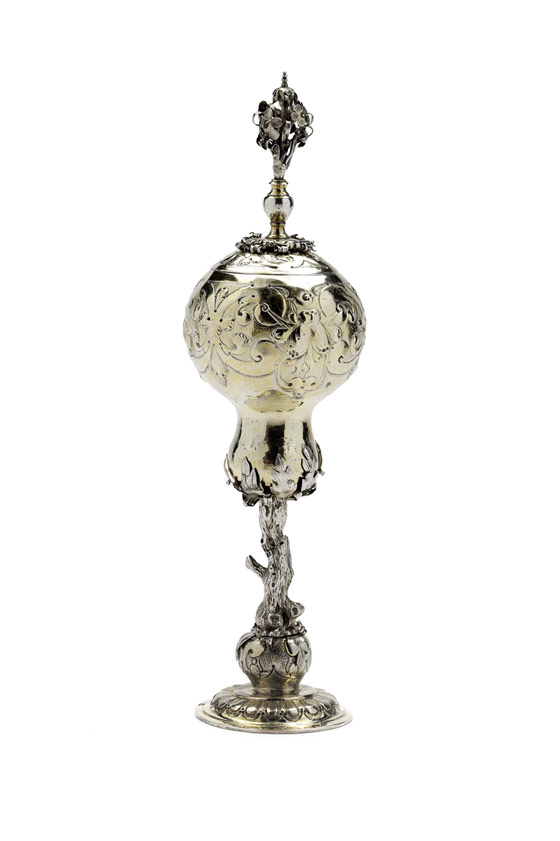Piriform standing cup and cover
Hans II Weienmayr (Master ca 1588–1630)
Augsburg, 1618–1622
Silver, cast, embossed, chased, fire-gilt
Master maker’s mark (Seling 2007, No. 1043) and town mark (Seling 2007, No. 1043) on the foot-ring, wriggled assay groove on the edge of the cover Engraved on the cover: ‘XV’
Height ca 26.5 cm, lower diameter ca 6.5 cm
Weight ca 228 g
SOLD - Please contact us for similar artwork!
Magnificent fire-gilt silver standing cups and covers, their bowls in the form of apples or pears on shafts designed in the form of a tree trunk or bough, became particularly popular in the sixteenth century. These elaborate examples of the goldsmith’s craft were usually regarded as precious objects for princely display as well as good investments that might be melted down in financial emergencies, ‘liquid assets’ that could be literally ‘converted to cash’. Because they were aesthetically so gratifying and worked of such valuable materials, they tended to be kept in secure treasury vaults, to which only princes and their stewards had access. The precious covered cups would be taken out of the vaults to be displayed as signs of power and riches on princely banqueting tables or on three- or five-tiered credenzas behind the banqueting board on festive occasions at court, such as the celebration of births or marriages and at diplomatic receptions or state visits. Its naturalistically designed shaft in the shape of a tree trunk, its bowl decorated with fine chasing and punching and its elegant finial in the form of a silver nosegay fashioned of sheet silver (German: Schmeck) reveal the present piriform standing cup and cover as an outstanding work of south German gold- and silversmithing. The town and master maker’s marks on the foot-ring and the cover verify this piece as a work by the Augsburg goldsmith Hans II Weienmayr (master ca 1588–1630), and date it to ca 1618–1622. In 1565 Weienmayr was training as a goldsmith in Nuremberg with Caspar Kraus, and by 1588 had already attained master craftsman status. Drinking vessels shaped like fruits were evidently Weienmayr’s speciality. Only two other works by Weienmayr are held at public museums: two pineapple cups in the Kremlin Armoury in Moscow and the Hamburg Museum für Kunst und Gewerbe respectively.

